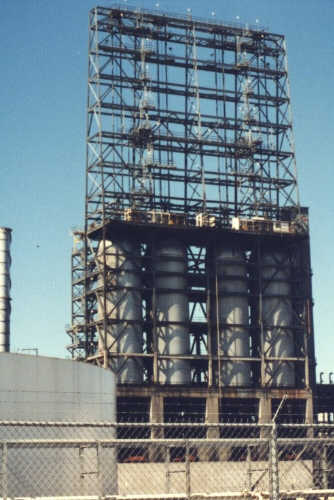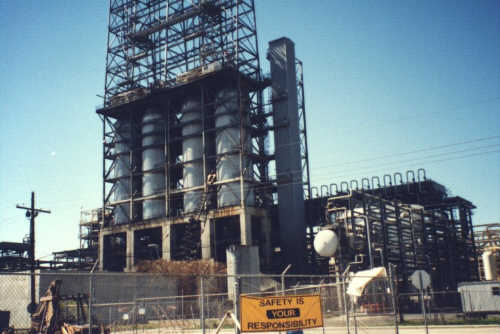This is on the north (east) bank of the Mississippi River in Norco, LA...when I was there it was in the then-town of Good Hope, and the refinery had previously been known as the Good Hope Refinery. I worked here for 2-1/2 years up through mid 1998--Fluor-Daniel had a management contract--depending on how the owner's cash situation was, I was one of 150+ Fluor-Daniel (F-D) folks managing hundreds of workers...or one of 8 F-D employees managing not many more pipefitters, millwrights, electricians and laborers. The place had been idle since the 1980's with more than one Chapter 11 in its history; during the construction phase I was in, there was an inflow of capital from junk bonds that kept the construction going for awhile. The bankruptcy monitors insisted for a time that a reputable contractor (Fluor) manage the construction--hence my presence as a field engineer. The work was actually being done by a captive contractor. For a time there were plans for Fluor to take over more of the work, but that never happened. After I left there was another bankruptcy or two, and the original owner Jack Stanley eventually ended up losing the place. More recently the refinery was renamed Orion Refining Company with an influx of capital from new investors including the Shaw Group that also did much of the final phase of construction. In June 2000 they started up the cat cracker and other new components of the plant--essentially the first "new" refinery to open in the US in a number of years. These pictures were taken in March 2000, about 3 months before the main part of the refinery was started up. The unit you see here was started up in late 1998.
This view is looking north at the portion of the plant where most of our work was. Actually our office trailers (gone now) were just on the other side of the fence. The stack in the center (by the steam cloud) is the stack for the old fired heaters that occupied the majority of my time. The narrow structure to the left houses a number of large heat exchangers on many levels--a major part of the project was to rebuild all of them. Here's another view from a slightly different angle. 
This is a view of the "coker structure"--the total refinery project was a mixture of revamping old units and adding new ones to support a different process. Briefly, petroleum coke is solid black stuff that is essentially a byproduct of petroleum refining. It is the residue from the stuff at the bottom of the distillation process--this liquid is heated (in the heaters I worked on) to 1200°+ F and pumped into these large vessels ("coke drums" perhaps 120' high and 30' in diameter, heavy wall special alloy steel). After it cools and hardens it is "drilled" with a high-pressure water cutting head that enters the top of the vessel (basically a drill rig) and "cuts" the coke so that it tumbles out the opened bottom and down the chute into a pile. Coke is used as a source of carbon in various industrial processes, for making electrodes, etc. The name of our portion of the work was the "delayed coker" project because that was the name of the process; however it also was jokingly used to describe the frequent delays to the project. Here's a web site from Southern Illinois University, that describes and depicts coke and the coking process in more detail than I imagined possible There is an elevator up to the level at the top of the coke drums (actually we also had a construction elevator) but these didn't always operate; plus since I was involved with engineering the installation of the coke cutting drills and associated steel modifications, I had to climb to the very top of the structure frequently--300+ feet above the ground, the top part was via ladder access only. 
Here's another view of the coke drums and storage pad area from the northeast. Actually for most of my time on site the foreground area was a sea of mud; hundreds of piles were driven to support everything you see. Remember we're 1/4 mile from the Mississippi River and about 25 miles upriver from the French Quarter. The concrete portion of the coker structure itself had been erected (and the drums themselves installed) in 1992-94 during an earlier period when the owner had money to spend. 
Some of the leftover equipment, manholes, and other junk that didn't get used. The process was changed several times. Plus, the owner had bought up lots of old used equipment "cheap" and I spent some time sorting through the main "storage areas" (much larger than this) looking for stuff to use. 
This is the enclosed conveyer belt system that was constructed to move the coke from the storage pad in front of the drums, to the river where a barge loading terminal had been built. This portion of the conveyor crosses over a former state highway that the refinery took over title to (after building a replacement road to current standards on the other/east side of the tank farm, and deeding it to the State.). Historical updates...first, on 7 June 2001 during Tropical Storm Allison, lightning struck one of the large floating-roof storage tanks--265' diameter/300,000 barrels, after the roof had previously collapsed. This was the world's largest such tank fire, it was extinguished 13 hours later with a massive foam attack. Here's an article about that from L'Observateur (although their photos have disappeared). A bit later, 29 January 2003, a major fire in the fractionator area shut down the west plant. This disaster plus the petroleum strikes in Venezuela (primary crude source for the unit) resulted in an Orion bankruptcy filing in May. In June 2003 the refinery was purchased by Valero Energy Corporation (East Bay Business Times article). And of course the unit suffered damage from Katrina in August 2005. Here is the Valero St. Charles Refinery information page. It is now known as the St. Charles Refinery. |